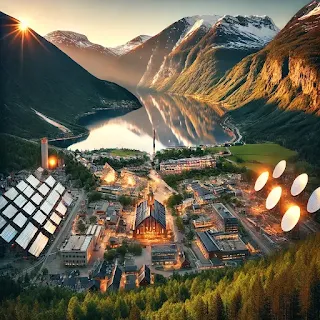Rjukan: Where Innovation Meets Nature
Rjukan: Norway's City of Shadows and Light
Tucked away in the deep valley of Telemark County, Rjukan is a Norwegian city unlike any other. Its history is steeped in industrial innovation, resilience, and an extraordinary relationship with sunlight. From its industrial past to its modern-day uniqueness, Rjukan stands apart from typical cities, offering a story of human ingenuity intertwined with nature's extremes.
A Legacy Forged in Industry
Rjukan's story began in the early 20th century, shaped by the visionary industrialist Sam Eyde. Recognizing the potential of the powerful Rjukanfossen waterfall, Eyde founded Norsk Hydro in 1905, harnessing the immense energy of the falls to produce fertilizer. This industrial venture transformed Rjukan from a remote valley into a bustling hub of innovation and engineering. The city's hydroelectric plants and the iconic Vemork power station not only powered industries but also placed Rjukan at the heart of Norway's industrial revolution.
During World War II, Rjukan gained international recognition due to its role in the fight against Nazi Germany's atomic ambitions. The Vemork plant was the site of the famous Norwegian heavy water sabotage, a daring resistance effort that significantly hindered Germany's nuclear weapons program. This historical episode cements Rjukan's place in global history, blending its industrial identity with heroism.
The City That Chased the Sun
What truly sets Rjukan apart is its ingenious solution to a natural challenge. Due to the steep mountains surrounding the valley, the city is deprived of direct sunlight for nearly six months each year. In 2013, Rjukan addressed this long-standing challenge by installing giant heliostats—mirrors strategically placed on the mountainside—to reflect sunlight into the town square. This innovative project not only brightens the winter days but also symbolizes the city's relentless spirit to overcome nature's limitations.
This relationship with light is celebrated annually through various festivals and events, drawing visitors curious about how Rjukan has turned a natural disadvantage into a remarkable attraction. The heliostats have become both a practical solution and a testament to human creativity, making Rjukan a beacon of innovation.
A UNESCO World Heritage Site
In recognition of its industrial significance, Rjukan, along with Notodden, was inscribed on the UNESCO World Heritage List in 2015. This designation honors the city's role in the early development of hydroelectric power and industrialization. Visitors can explore the well-preserved Vemork Museum, ride the historic Krossobanen cable car—Europe's first of its kind—and hike the trails that offer stunning views of both industrial marvels and natural beauty.
Nature's Playground
Beyond its industrial and historical identity, Rjukan offers outdoor adventures that set it apart from other cities. The nearby Gaustatoppen mountain, often called Norway's most beautiful peak, provides panoramic views that stretch across a sixth of the country on clear days. In winter, the area transforms into a haven for ice climbers and skiers, while the summer months invite hikers and nature lovers.
A City Unlike Any Other
Rjukan's unique blend of industrial heritage, wartime heroism, and innovative adaptation to its environment makes it a city that defies norms. It is a place where history, nature, and human creativity converge, offering a distinct experience far removed from the conventional cityscape. Whether you're drawn by its storied past, captivated by its dance with sunlight, or seeking adventure in its rugged surroundings, Rjukan promises a journey unlike any other.




Comments
Post a Comment